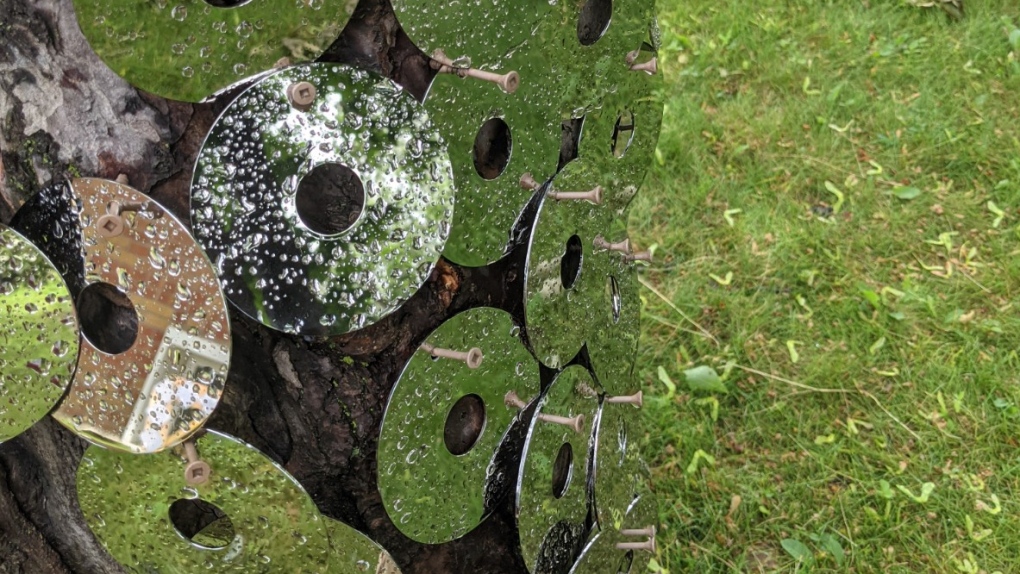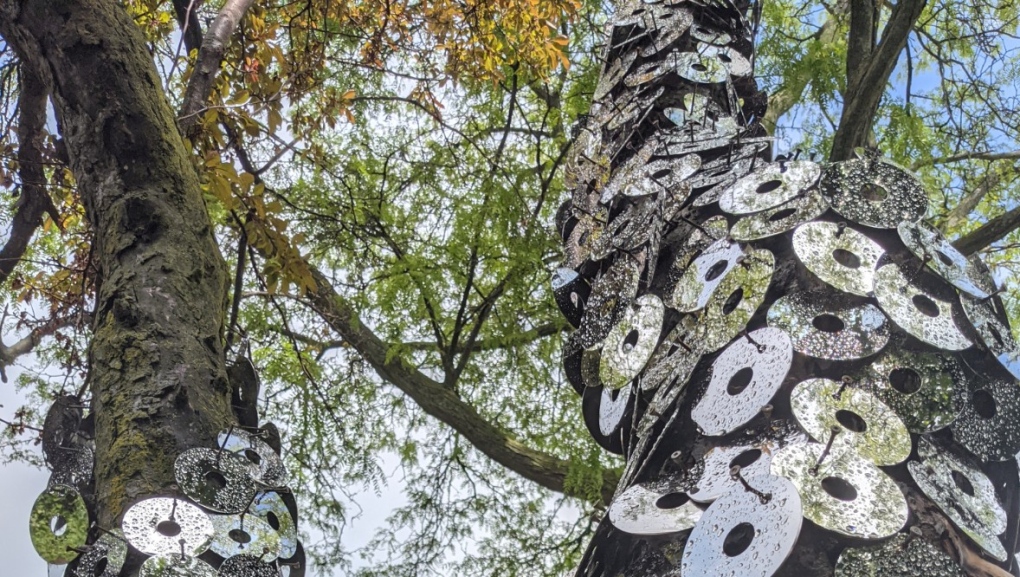Toronto artist constructs disco tree to slow down traffic
 Paul Fegun constructed a disco tree on his front lawn to slow down traffic.
Paul Fegun constructed a disco tree on his front lawn to slow down traffic.
A Toronto resident constructed a “disco tree,” made out of 650 hard drive platters, to solve a local traffic problem.
“I originally started to put large pieces of art on my front lawn because it helped people to slow down. They would stop and think,” says Paul Fegun.
Since 1971, Fegan has lived on Brenda Crescent in Scarborough. In recent years, he noticed cars would accelerate on the formerly quiet residential street. Often, he says, traffic on Danforth Road or Kennedy Road and St. Clair Avenue results in speeding and congestion in the neighbourhood.
 Paul Fegun constructed a disco tree on his front lawn to slow down traffic.
Paul Fegun constructed a disco tree on his front lawn to slow down traffic.
For three weeks, Fegan gathered and deconstructed hundreds of hard drives, which he estimates contain between 600 and 1,000 terabytes of data. Then, he loosely screwed them onto the tree outside of his house. Like chimes, the hard drives sway in the wind.
“It’s like looking at a sequined dress,” he says.
 Paul Fegun constructed a disco tree on his front lawn to slow down traffic.
Paul Fegun constructed a disco tree on his front lawn to slow down traffic.
Fegan notes that the tree has been dead for a decade, but due to childhood nostalgia, he decided to give it an afterlife, rather than knock it down.
Prior to becoming an artist, Fegan worked in IT for 25 years, which explains why much of his art is made up of electronics. “Now, I dismantle the stuff that gave me headaches,” he says.
This afternoon, Fegan spoke to his local city councillor to discuss potential solutions to slow down the traffic. They discussed putting up city signage encouraging drivers to slow down, but Fegan decided, “I’ll just make my own [signs],” he said. “They’ll be big.”
CTVNews.ca Top Stories

LIVE NOW Budget 2024 prioritizes housing while taxing highest earners, deficit projected at $39.8B
In an effort to level the playing field for young people, in the 2024 federal budget, the government is targeting Canada's highest earners with new taxes in order to help offset billions in new spending to enhance the country's housing supply and social supports.
BUDGET 2024 Feds cutting 5,000 public service jobs, looking to turn underused buildings into housing
Five thousand public service jobs will be cut over the next four years, while underused federal office buildings, Canada Post properties and the National Defence Medical Centre in Ottawa could be turned into new housing units, as the federal government looks to find billions of dollars in savings and boost the country's housing portfolio.
Some of the winners and losers in the 2024 federal budget
With a variety of fiscal and policy measures announced in the federal budget, winners include small businesses and fintech companies while losers include the tobacco industry and Canadian pension funds.
From housing initiatives to a disability benefit, how the federal budget impacts you
From plans to boost new housing stock, encourage small businesses, and increase taxes on Canada’s top-earners, CTVNews.ca has sifted through the 416-page budget to find out what will make the biggest difference to your pocketbook.
Liberals aim to hit the brakes on car theft with new criminal offences
The Liberals are proposing new charges for the use of violence while stealing a vehicle and for links to organized crime, as well as laundering money for the benefit of a criminal organization.
Police to announce arrests in Toronto Pearson airport gold heist
Police say that arrests have been made in connection with a $20-million gold heist at Toronto Pearson International Airport one year ago.
Teen hockey players arrested for sexual assault following hazing incident: Manitoba RCMP
Three teenagers were arrested in connection with a pair of alleged hazing incidents on a Manitoba hockey team, police say.
Feds offer $5B in Indigenous loan guarantees, fall $420B short on infrastructure asks
The federal government is providing up to $5 billion in loan guarantees to help Indigenous communities invest in natural resource and energy products. But when it comes to a promise to close what advocates say is a sprawling Indigenous infrastructure gap, Ottawa is short more than $420 billion.
BUDGET 2024 Ottawa police get $50 million to boost security around Parliamentary Precinct
The Ottawa Police Service will receive $50 million in new federal funding over the next five years to "enhance security" around the Parliamentary Precinct.































